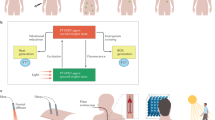Abstract
Mechanisms for improving photodynamic therapy (PDT) were investigated in the murine RIF1 tumour using meso-tetrahydroxyphenylchlorin (m-THPC) or bacteriochlorin a (BCA) as photosensitisers and comparing these results with Photofrin-mediated PDT. The 86Rb extraction technique was used to measure changes in perfusion at various times after interstitial PDT. Non-curative combinations of light doses with m-THPC and BCA PDT markedly decreased vascular perfusion. This decrease was more pronounced for both new photosensitisers than for Photofrin. Comparison of tumour perfusion after PDT with tumour response revealed an inverse correlation for all three photosensitisers, but the relationship was less clear for m-THPC and BCA. In vivo/in vitro experiments were performed after Photofrin or m-THPC PDT in order to assess direct tumour kill (immediate plating) vs indirect vascular effects (delayed plating). For both photosensitisers, there was little direct cell killing but clonogenic survival decreased as the interval between treatment and excision increased. When m-THPC PDT was combined with mitomycin C (MMC), light doses could be decreased by a factor of 2 for equal tumour effects. Lower light and m-THPC doses could be used compared with Photofrin PDT in combination with MMC. BCA PDT with MMC did not result in a greater tumour response compared with BCA PDT alone. Reduction in both light and photosensitiser does for effective PDT regimes in combination with MMC offers substantial clinical advantages, since both treatment time and skin photosensitisation will be reduced.
This is a preview of subscription content, access via your institution
Access options
Subscribe to this journal
Receive 24 print issues and online access
$259.00 per year
only $10.79 per issue
Buy this article
- Purchase on Springer Link
- Instant access to full article PDF
Prices may be subject to local taxes which are calculated during checkout
Similar content being viewed by others
Author information
Authors and Affiliations
Rights and permissions
About this article
Cite this article
van Geel, I., Oppelaar, H., Oussoren, Y. et al. Mechanisms for optimising photodynamic therapy: second-generation photosensitisers in combination with mitomycin C. Br J Cancer 72, 344–350 (1995). https://doi.org/10.1038/bjc.1995.336
Issue Date:
DOI: https://doi.org/10.1038/bjc.1995.336
This article is cited by
-
Schedule-dependent interaction between Doxorubicin and mTHPC-mediated photodynamic therapy in murine hepatoma in vitro and in vivo
Cancer Chemotherapy and Pharmacology (2006)
-
Foscan® uptake and tissue distribution in relation to photodynamic efficacy
British Journal of Cancer (2003)
-
Implicit and explicit dosimetry in photodynamic therapy: a New paradigm
Lasers in Medical Science (1997)



